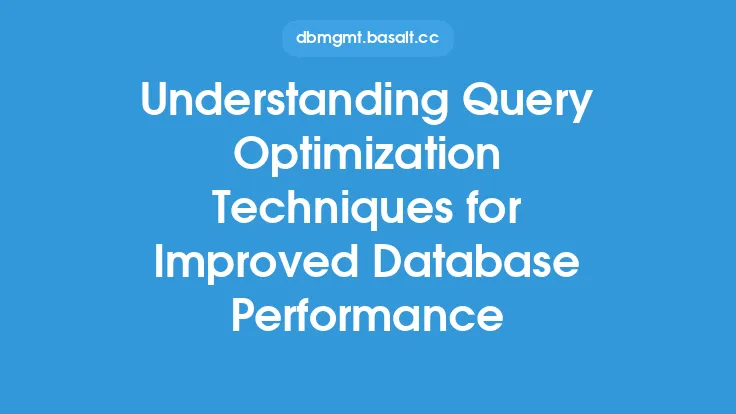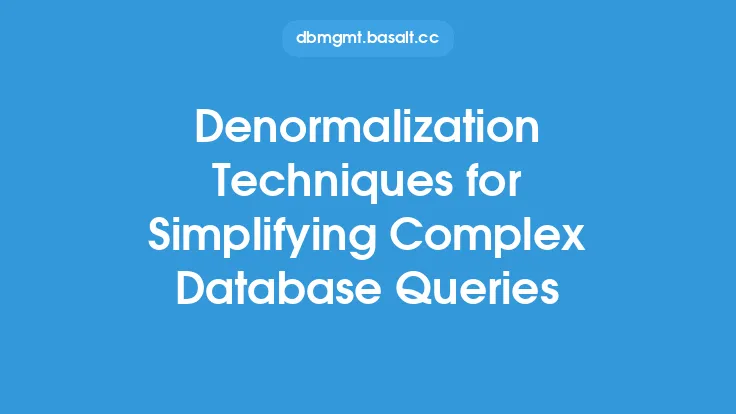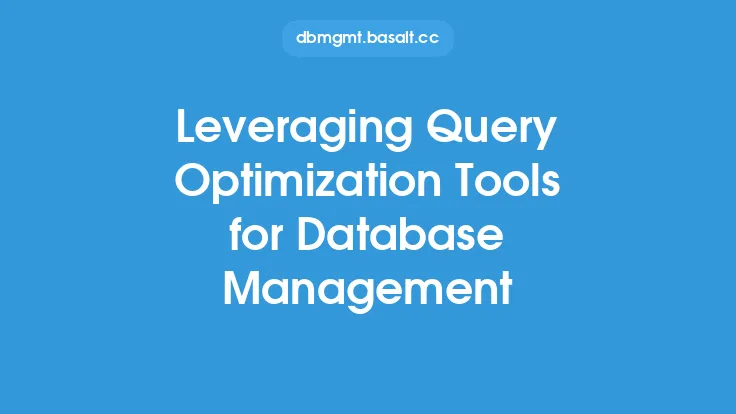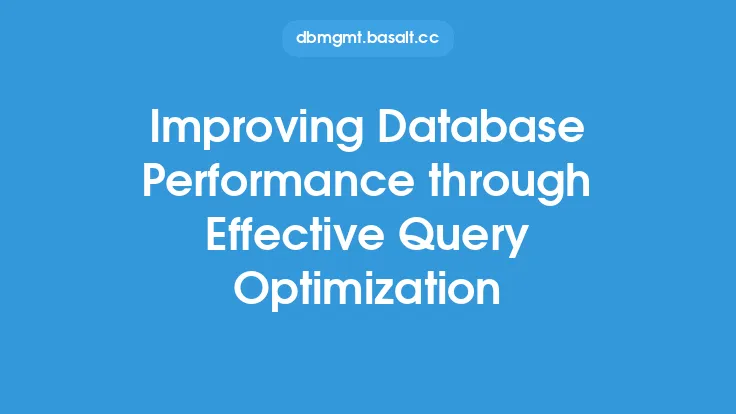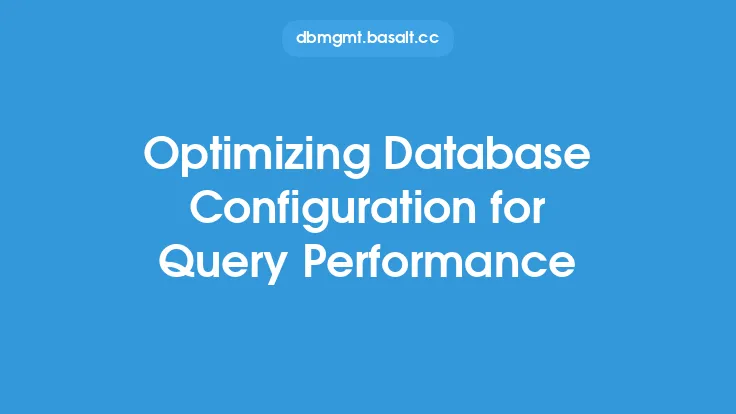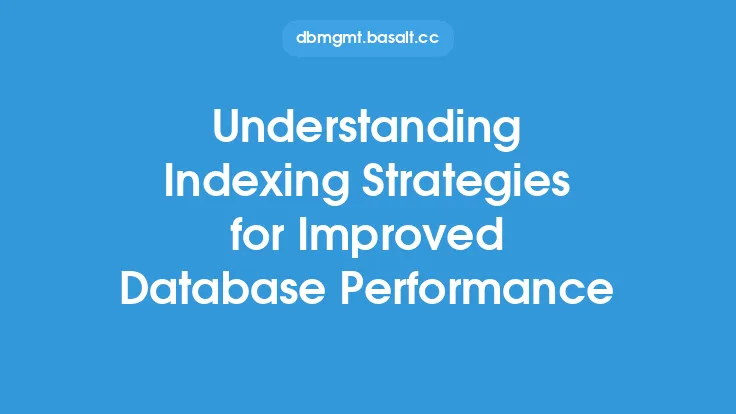When dealing with complex database queries, optimizing them is crucial to improve the overall performance of the database. Complex queries can be resource-intensive and may lead to slower execution times, which can negatively impact the user experience and overall system efficiency. In this article, we will delve into the various query optimization strategies that can be employed to improve the performance of complex database queries.
Understanding Query Optimization
Query optimization is the process of analyzing and modifying database queries to improve their performance. This involves identifying the most efficient way to execute a query, reducing the amount of resources required, and minimizing the execution time. Query optimization is a critical aspect of database performance optimization, as it can significantly impact the overall performance of the database. There are several techniques that can be used to optimize queries, including indexing, caching, and rewriting queries.
Indexing Strategies
Indexing is a powerful technique for optimizing queries. An index is a data structure that improves the speed of data retrieval by providing a quick way to locate specific data. There are several types of indexes, including B-tree indexes, hash indexes, and full-text indexes. B-tree indexes are the most common type of index and are used to index data that is stored in a B-tree data structure. Hash indexes are used to index data that is stored in a hash table, and full-text indexes are used to index text data. By creating indexes on columns that are frequently used in queries, the database can quickly locate the required data, reducing the execution time of the query.
Query Rewriting Techniques
Query rewriting is another technique that can be used to optimize complex database queries. This involves rewriting the query to make it more efficient, without changing the result set. There are several techniques that can be used to rewrite queries, including simplifying subqueries, eliminating unnecessary joins, and reordering the join operations. Simplifying subqueries involves rewriting subqueries to make them more efficient, such as by using joins instead of subqueries. Eliminating unnecessary joins involves removing joins that are not necessary for the query, reducing the amount of data that needs to be processed. Reordering the join operations involves reordering the joins to reduce the amount of data that needs to be processed.
Caching Mechanisms
Caching is a technique that can be used to optimize queries by storing frequently accessed data in memory. This reduces the need to access the disk, which can significantly improve the performance of the query. There are several types of caching mechanisms, including result caching, data caching, and query caching. Result caching involves storing the results of a query in memory, so that if the same query is executed again, the results can be retrieved from memory instead of being recalculated. Data caching involves storing frequently accessed data in memory, reducing the need to access the disk. Query caching involves storing the execution plan of a query in memory, so that if the same query is executed again, the execution plan can be retrieved from memory instead of being recalculated.
Statistics and Histograms
Statistics and histograms are critical components of query optimization. Statistics provide information about the distribution of data in the database, such as the number of rows, the data types, and the distribution of values. Histograms provide a graphical representation of the distribution of data, making it easier to understand the data distribution. By analyzing statistics and histograms, the database can determine the most efficient way to execute a query, reducing the execution time and improving the overall performance of the database.
Join Order Optimization
Join order optimization is a critical aspect of query optimization. The order in which tables are joined can significantly impact the performance of the query. There are several techniques that can be used to optimize the join order, including using the nested loop join algorithm, the hash join algorithm, and the merge join algorithm. The nested loop join algorithm involves joining two tables by iterating over the rows of one table and matching them with the rows of the other table. The hash join algorithm involves joining two tables by creating a hash table of one table and then matching the rows of the other table with the hash table. The merge join algorithm involves joining two tables by sorting the rows of both tables and then merging them.
Subquery Optimization
Subquery optimization is another critical aspect of query optimization. Subqueries can be resource-intensive and may lead to slower execution times. There are several techniques that can be used to optimize subqueries, including using the IN operator instead of the EXISTS operator, using joins instead of subqueries, and using window functions instead of self-joins. The IN operator is used to test whether a value is in a list of values, while the EXISTS operator is used to test whether a subquery returns any rows. Using joins instead of subqueries can reduce the amount of data that needs to be processed, improving the performance of the query. Window functions can be used to perform calculations over a set of rows, reducing the need for self-joins.
Parallel Query Execution
Parallel query execution is a technique that can be used to optimize complex database queries. This involves executing multiple operations of a query in parallel, reducing the overall execution time. There are several techniques that can be used to execute queries in parallel, including using multiple CPU cores, using parallel indexing, and using parallel sorting. Using multiple CPU cores involves executing multiple operations of a query on different CPU cores, reducing the overall execution time. Parallel indexing involves creating indexes in parallel, reducing the time it takes to create an index. Parallel sorting involves sorting data in parallel, reducing the time it takes to sort the data.
Query Optimization Tools
Query optimization tools are software applications that can be used to optimize complex database queries. These tools provide a range of features, including query analysis, indexing recommendations, and caching recommendations. Query analysis involves analyzing the query to identify performance bottlenecks and providing recommendations for improvement. Indexing recommendations involve recommending indexes that can be created to improve the performance of the query. Caching recommendations involve recommending caching mechanisms that can be used to improve the performance of the query. By using query optimization tools, database administrators can quickly and easily optimize complex database queries, improving the overall performance of the database.
Best Practices for Query Optimization
There are several best practices that can be followed to optimize complex database queries. These include using efficient join orders, using efficient subquery techniques, and using efficient indexing strategies. Using efficient join orders involves using the most efficient join algorithm for the query, reducing the amount of data that needs to be processed. Using efficient subquery techniques involves using the most efficient subquery technique for the query, reducing the amount of data that needs to be processed. Using efficient indexing strategies involves creating indexes on columns that are frequently used in queries, reducing the time it takes to execute the query. By following these best practices, database administrators can optimize complex database queries, improving the overall performance of the database.
Conclusion
Query optimization is a critical aspect of database performance optimization. By using various query optimization strategies, including indexing, caching, and rewriting queries, database administrators can improve the performance of complex database queries. Additionally, by using query optimization tools and following best practices, database administrators can quickly and easily optimize complex database queries, improving the overall performance of the database. By optimizing complex database queries, database administrators can improve the user experience, reduce the execution time, and improve the overall efficiency of the system.
